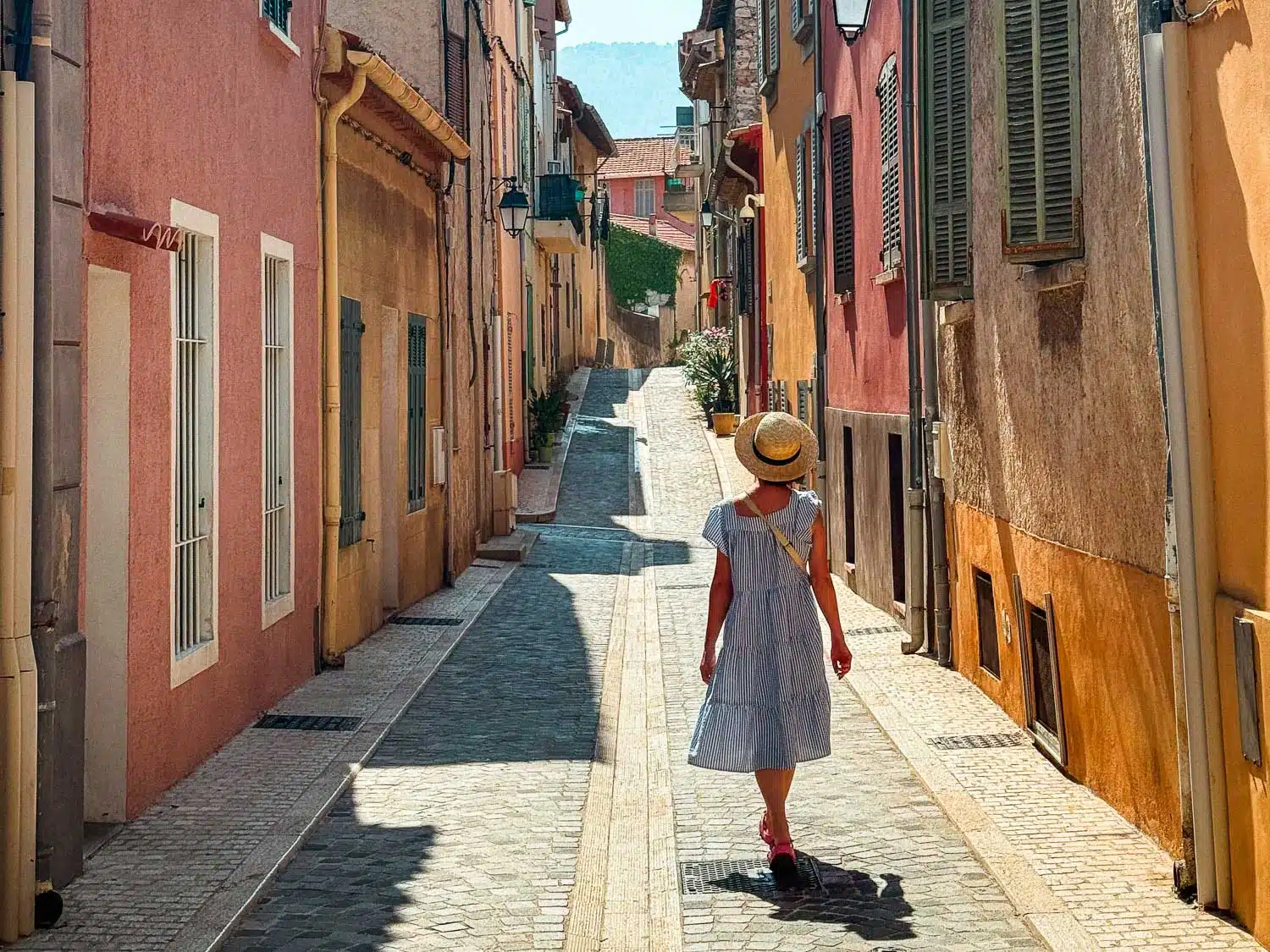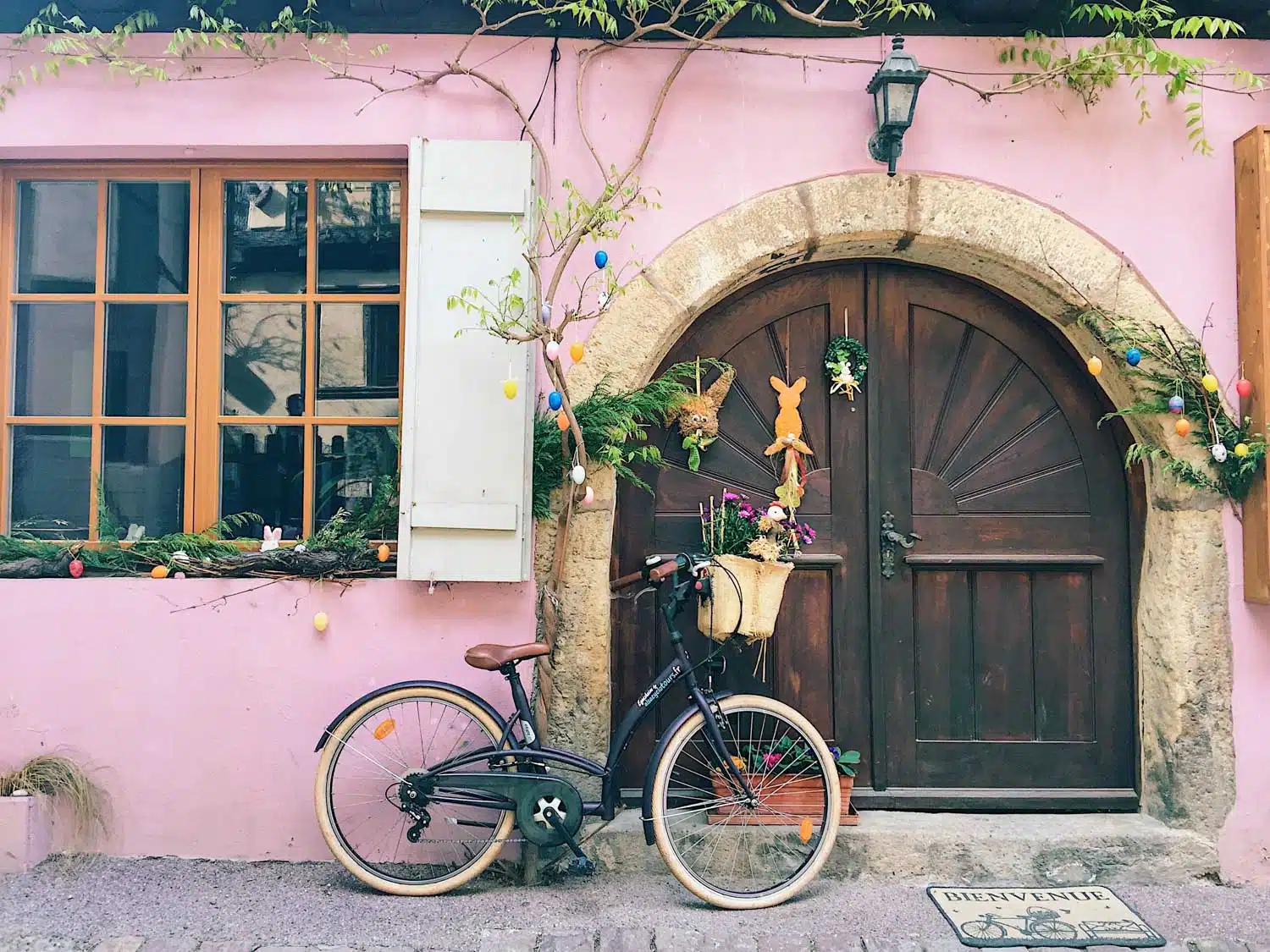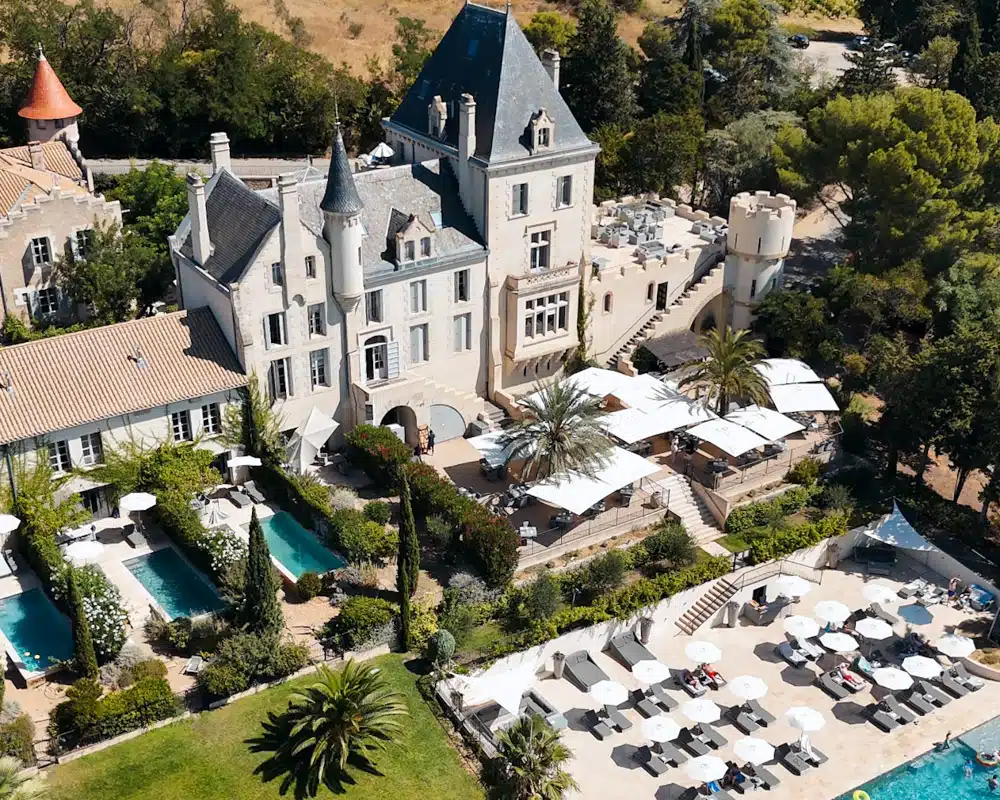Last updated on June 24, 2025

I know it might sound hyperbolic. But I think France might just be one of the world’s best countries for a road trip. It just has so much going for it, from fairytale towns to rolling vineyards to elegant cities and miles of varied coastline. Plus within every region there’s a surprise – be it a stupendously beautiful lake or Europe’s answer to the Grand Canyon. It’s the stuff of road trip dreams.
Between Steve and I, we’ve travelled all over France doing road trips, city breaks and more. I went there almost every year as a young adult. This post is an amalgamation of everything we’ve learned and gives you the tools to create your best France road trip. It includes a quick guide to the regions and practical tips on getting around. See this other post for 10 suggested France itineraries.
Or, if you already have your heart set on a specific region, we have full road trip itineraries for the South of France and the West Coast. Plus if you’re combining it with a dip into Switzerland and Italy, see this colourful road trip itinerary.
All our France travel tips
Itineraries: How to plan a France road trip | 10 gorgeous France itineraries | Colourful Europe road trip (France, Switzerland and Italy) | Provence road trip | West Coast France Road Trip
City and accommodation guides: Annecy travel guide | Colmar and Eguisheim travel guide | France family surf camp | Chateau Les Carrasses review
Bridges and Balloons’ France road trip highlights





Here’s a quick guide to our French road trip highlights….
- The colourful towns of the Alsace region, like Colmar and Eguisheim, look like something straight out of a fairytale.
- We loved surfing in the Medoc region, where the miles of beach mean it always feels fairly secluded and wild.
- Lake Annecy is one of the most beautiful places we’ve ever been – a sparkling lake backed by the Alps and surrounded by pretty towns. Cycle around the perimeter for a perfect day out.
- There are many wine regions to choose from. My favourite for taste is the Beaujolais area near Lyon, but the Loire is the most iconic.
- The Verdon Gorge is spectacular – be sure to ride a boat or paddleboard down the centre.
- Paris is one of my favourite places in the world for a city break – head to the 11th for hip wine bars and bistros, and by day, wander the Marais.
- On the pretty island of Ile de Re, bikes are the preferred mode of transport, which makes for a peaceful, laid-back escape.
- Pont d’Arc in the Ardeche is super touristed, but still worth seeing. Stay nearby to avoid the nightmare of public parking!
- Dune du Pilat, the biggest sand dune in Europe, wowed us all. And I was charmed by the elegant holiday town of Archachon.
- The wrench love to camp and you’re spoiled for choice with different campsites. Our favourite brand is Huttopia, which has glamping and camping sites across the country.
- Cassis is my favourite coastal town – stylish enough to get that French Riviera vibe without being so glitzy you feel out of place.
- The hilltop towns of Provence and the Luberon are as dreamy as they look – don’t miss Gordes, Roussillon and Loumarin.
How long do you need for a France road trip?

It’s one of those ‘how long is a piece of string’ questions. France is a big country, around 590 miles long and 620 miles wide, and there is a hell of a lot to see. If you had a month and you were travelling quickly, you could tick off a big portion of the highlights. But chances are you’ll want to take your time, and we really do recommend having those moments to soak it all in. Personally, I think you need at least two weeks for most individual regions, be it Provence or the Atlantic Coast.
The best approach is to choose some of your own must-sees and craft a road trip around that, bearing in mind the distances between each place. It might be that you choose a theme – like one of the wine regions or a period in history – and shape your trip around that. Or you could choose a specific region like Brittany, and then make a route around your priorities. I’ve included some suggested themes and France road trip itineraries in the sections below.
When to visit France?

France can be a good road trip destination year-round, but the best time to visit depends on what you want to experience.
Spring (March to May) offers mild weather and blooming landscapes, perfect for countryside drives and vineyard tours, while summer (June to August) brings warm temperatures ideal for coastal trips along the French Riviera and long, balmy evenings in charming towns. However, summer is also the busiest and most expensive time, so be prepared for crowds and higher prices, especially in August when all of France takes a vacation.
Autumn (September to November) is great for scenic drives through fall foliage and wine regions like Burgundy, while winter (December to February) is the time to enjoy festive markets, ski trips in the Alps, and quieter countryside escapes.
If you prefer fewer tourists and more comfortable driving conditions, spring and autumn are your best bets. Summer is ideal for beach lovers and festival-goers, while winter is a magical time for holiday charm and skiing.
Personally, despite the busyness, I love France in the summer when you can swim in the lakes and sea, and enjoy all the vacation vibes.
Where to visit in France? A quick guide to the regions






Choosing where to visit in France can be pretty mind-boggling as it’s a huge country and the diversity of what it offers is vast. Pick any sort of landscape, and it’s likely on offer, from snow-capped mountains to sand dunes reminiscent of the Sahara. Here’s a quick overview of the regions to get you started on planning your road trip.
Paris and Île-de-France
For a road trip, you might want to skip Paris and save it for a separate city break, but it’s also a good place to start/end your journey. Just outside the city, places like the Palace of Versailles, Monet’s Garden and the forest of Fontainebleau are other places to explore.
Normandy and Brittany
Known for its dramatic cliffs, World War II history, and charming seaside towns, Normandy is a brilliant region for history lovers. Visit Mont-Saint-Michel, the beautiful medieval island commune, or explore the D-Day landing beaches.
Brittany, with its rugged coastlines and Celtic culture, offers something completely different from other regions in France. It’s perfect for nature lovers and those interested in mythology and folklore. Try the local seafood and visit the charming walled town of Saint-Malo.
The Loire Valley and Central France
The Loire Valley and Burgundy are two of France’s most famous wine regions. The Loire is known for its rolling vineyards and grand châteaux, and is where you’ll find the iconic Château de Chambord. While Burgundy is more about mustard fields and medieval villages. The lesser-known neighbouring Auvergne region is home to ancient volcanoes, lush valleys, and remote villages.
Provence and South Eastern France
For sun-drenched beauty, lavender fields, and charming villages, head to Provence. Explore historic towns like Avignon and Gordes, or wind your way to the glamorous French Riviera, with its sparkling Mediterranean coastline, home to Cannes, Nice, and Monaco. For me, Provence is France’s most consistently beautiful region (although I prefer the area inland to the coast).
Alsace, Jura and the French Alps
Alsace, with its half-timbered houses and scenic wine routes, offers yet another side to France, this time with German influence (we particularly love Colmar and Equisheim). Or for a more Swiss influence, head to the French Alps. During summer, you can enjoy hiking trails and crystal-clear lakes (including my favourite, Annecy) and in winter, these roads will take you to some of Europe’s best ski resorts.
The Pyrenees and Southwest France
Stretching along the border with Spain, the Pyrenees offer a dramatic and rugged landscape ideal for outdoor adventures. This region is perfect for hiking, cycling, and winter sports, with stunning peaks and valleys to explore. Visit Lourdes for something different.
In the Southwest, you’ll also find Languedoc-Roussillon with its Mediterranean beaches, vineyards, and medieval fortresses. Highlights include the Canal du Midi, the walled city of Carcassonne, and the vibrant city of Montpellier.
The Atlantic Coast
Stretching from Brittany down to the Basque Country, the Atlantic Coast offers long sandy beaches and a more laid-back vibe than the Mediterranean. You’ll find charming towns like La Rochelle, known for its maritime history, and Arcachon, famous for the towering Dune du Pilat. Surfing is a big draw in places like Hossegor and Biarritz, and the region is also great for cycling, with scenic routes that hug the coast.
And inland from the Atlantic, you also have the Dordogne, famous for its cuisine and fortified villages. And the Lot Valley with its pretty riverside villages.
Ideas for France road trip itineraries
We have a full post full of France itinerary ideas, where we and other bloggers have put together a bunch of suggested itineraries. We also have three very detailed itinerary posts of our own road trips in Provence, the Atlantic Coast, and one that dips into Switzerland and Italy too.
Here’s a quick overview of some of the routes we suggest:
Provence road trip



Our Provence road trip takes you through the highlights of the region, from the lavender fields to the hilltop towns to the beaches of the French Riviera. And don’t forget the natural wonders of the Verdon Gorge and Calanque National Park. Our route is a loop from Aix-en-Provence. If you only experience one region of France, we think this should be it.
West Coast France road trip



The west coast of France veers from wild surf beaches to serene vacation towns and elegant cities. Don’t miss the epic Dune du Pilat, and be sure to explore some of the wine regions too. Our route takes you from La Rochelle all the way down to the border with Spain (with the option to extend into San Sebastian too).
Alsace – Switzerland – Italy – French Riviera



Starting in Colmar before winding through Switzerland down to Lake Como and then Cinque Terre, this route ends along the French Riviera. It’s an ideal option if you want to pack in more than one county on your route. I also think it might be the most instagrammable road trip in Europe with colourful buildings aplenty!
More French road trip ideas






See the France road trip ideas post for more itinerary inspiration. And also check out our destination and accommodation guides for: Lake Annecy, Ujusansa Family Surf Camp, Chateau Carrasses, and Colmar & Eguisheim.
Tips for Driving in France

Driving in France is pretty easy, with well-maintained roads and plenty of scenic routes. However, there are a few important things to keep in mind.
Be Aware of the toll roads
France has a widespread toll road system (autoroutes), which can be a quick and easy way to get from one region to another. However, the costs can add up, especially if you’re covering long distances. Make sure to budget for tolls or, if you prefer a more scenic drive, plan your route to avoid them. Toll charges vary depending on the distance travelled, but you can expect to pay about €10 to €60 for longer trips. This is a handy toll calculator where you can add your route and calculate the tolls in advance.
Where to hire a car in France
We use Discover Cars for hiring cars as they normally have better deals than booking directly with the provider. Also book your car insurance with a separate provider like RentalCover.com as this is far cheaper than booking directly. We always get an annual policy.
Most airports in France have car rental companies, and it’s usually cheaper to hire a car from an airport than a city centre location.
When choosing a car, consider the type of roads you’ll be traveling on. A compact car is ideal for narrow village and city streets, while a larger vehicle is more comfortable for long distances or for carrying camping gear etc. Also consider if you need to hire car seats or will be bringing your own. We normally try to bring our own as it’s free to bring them on the plane, plus it means we avoid getting a potentially low-quality one (a common issue with car hire companies!)
How to bring your own car to France
Bringing your own car can be a great option for saving money, but do bear in mind what part of France you’re trying to get to. For example, for our road trip in Provence, we got a Eurostar/train all the way down to Aix-en-Provence and then hired a car from there. We really didn’t fancy the long car journey with two little kids, so the train journey was far more enjoyable.
If you are taking your own car and traveling from the UK, you can take the ferry or use the Eurotunnel. The ferry crossing can be a scenic experience, but there tend to be long lines to board. Plus the Eurotunnel is faster (around 35 minutes), making it a popular choice.
If you choose the ferry, there are several routes that operate between the UK and France, such as Dover to Calais, Portsmouth to Caen, or Newhaven to Dieppe. You can even get a ferry all the way to Santander in Spain from Portsmouth.
The Eurotunnel operates between Folkestone and Calais, and you can drive straight onto the shuttle, which carries cars and passengers through the tunnel.
Once in France, you’ll need to carry your vehicle registration documents, insurance certificate, and a UK sticker. It’s also mandatory to have a warning triangle, reflective jacket, and spare light bulbs in your car.
Found this useful? Share it on Pinterest!


All our France travel tips
Itineraries: How to plan a France road trip | 10 gorgeous France itineraries | Colourful Europe road trip (France, Switzerland and Italy) | Provence road trip | West Coast France Road Trip
City and accommodation guides: Annecy travel guide | Colmar and Eguisheim travel guide | France family surf camp | Chateau Les Carrasses review

This looks pretty amazing , and Gorgeous photos , Thanks a lot 🙂